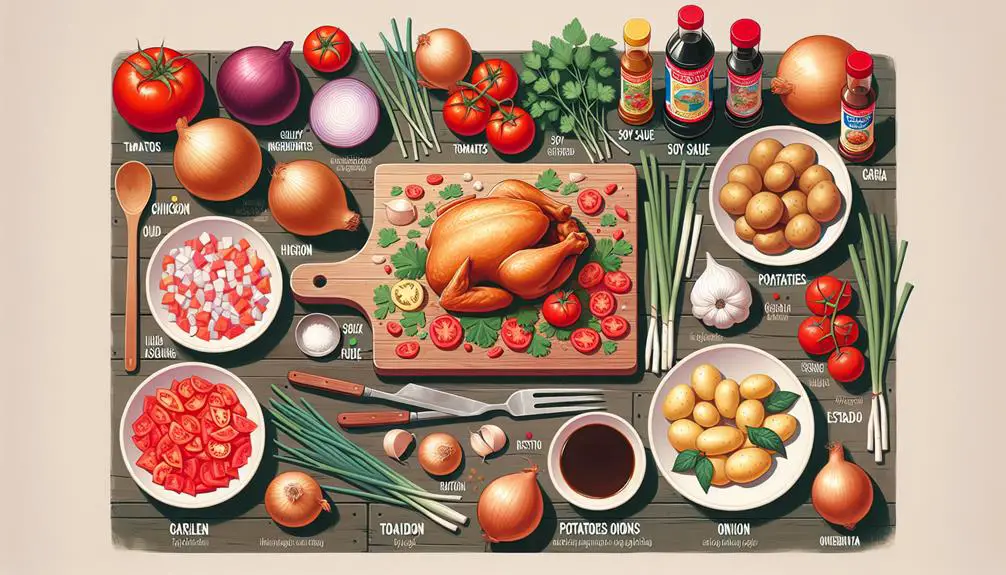Chicken Estofado is a tasty dish with a rich history. It originated in Spain and later made its way to Filipino cuisine. Over time, it has become a popular and beloved meal, adapted to local tastes.
This savory stew has evolved through cultural exchanges and has different recipe variations depending on the region.
Historical Roots of Stews

Stews have been around for a super long time, and every culture has their own special kinds. They’ve totally influenced dishes like the Peruvian Chicken Estofado.
This dish has a cool history that goes way back to when Spanish bullfighters’ families used to cook with bull meat. Imagine the yummy flavors from Spain mixing with Peruvian smarts when they added the ají panca chili pepper.
That’s how they made the stew their own!
Stews show how cooking has changed over time, with different ingredients and cultures making the dishes we love today.
The Spanish brought their estofado to Peru, and at first, it was only for fancy people. But as time went on, more people could get beef, so estofado de res became popular.
Then, when more people started raising chickens, that’s when the chicken version became a hit.
When you make Estofado de Pollo, you’re not just cooking – you’re making history. You’re sealing chicken like they did a long time ago to keep in the flavors.
Maybe you’ll even add some red wine for a modern twist. With each ingredient – like carrots, peas, and the special ají panca – you’re celebrating how people have changed and made new yummy things.
Spanish Culinary Traditions

Let’s talk about how Spanish food traveled to the Philippines and other Spanish colonies.
The Spanish brought their special recipe for estofado, a kind of stew, with them.
When they got to the Philippines, they changed the recipe a bit to fit the local tastes and what ingredients were available.
The Filipino estofado is like the Spanish one, but it has its own style. It’s a mix of Spanish and Asian flavors, with a little bit of sugar and soy sauce added.
They also use local fruits and meats to make it their own.
In other places where the Spanish went, like the Caribbean and the Andean highlands, they made the stew with different things, like plantains or potatoes.
This shows how the recipe can change to fit different places.
The recipe for estofado has been around for a long time and has changed a lot as it traveled to different countries.
It’s not just a meal; it’s also a way to learn about history and how people’s food can change over time.
Spread to the Philippines

When the estofado recipe came to the Philippines, it became a part of Filipino food in different ways.
In the north, they make ‘estofado Ilokano’ with sugarcane vinegar and soy sauce. They use special chickens and it tastes tangy and savory.
In the central islands, they add bananas and pickled papaya to make it a bit sweet and tart.
In Mindanao, they use coconut milk and spices to make it creamy and sometimes spicy.
Even though estofado is the same dish, each place in the Philippines makes it special with their own flavors. It’s like a part of their history in a bowl.
Key Ingredients and Cooking Techniques

When you pick a good chicken, it’s like the first step to making a yummy estofado de pollo. You should choose a fresh, plump bird with lots of meat and not too many bones.
It’s best to get a whole chicken that you can cut into pieces yourself, and make sure each piece has skin on it for extra flavor.
After you get the chicken, you just have to dry it, put some salt, pepper, and maybe cumin on it, and then cook it in hot oil until it’s brown all over. This makes the stew taste really good.
For the tasty flavors, you need garlic, onion, and ají panca chili pepper. Cook them until they smell really good.
This makes the stew taste like the ones from Latin America.
Now, for cooking it, put the chicken back in the pot with carrots, peas, and potatoes, and pour in the chicken stock. This makes the stew even more delicious.
Cultural Significance

In Latin America, estofado de pollo is a special dish for festivals and parties.
It shows how people come together and remember their culture and history. It’s not just about being hungry; it’s about celebrating with food.
Each bite tells a story from the past, passed down through families. The dish is a little different depending on where you are.
Some places make it really spicy with special peppers, while others make it sweeter with raisins or plantains. But no matter what, each place is proud of their own way of making it.
During holidays and big celebrations, estofado de pollo is more than just a meal. It’s the main thing that shows how families and friends are together.
You can see a big pot cooking, and it smells so good that everyone comes over.
It’s a time to share stories and make memories, and every spoonful helps to bring people closer and remind them what it’s like to be part of a group.
Evolution of Chicken Estofado

The way Filipino chicken estofado is made has changed over time. It used to be more like Spanish food, but now it’s different because Filipino chefs have made it their own.
In the Philippines, chicken estofado shows the country’s history and mix of cultures.
Instead of using beef, they use chicken, and they put in local stuff like soy sauce and banana blossoms. Some versions even have coconut milk for more flavor.
Nowadays, chefs are doing new things with estofado, like adding pineapple or spicy chilies. They’re also making it look different but it still tastes good.
Whether it’s the old way or a new way, chicken estofado is still a favorite Filipino food.
Notable Recipes

Let’s explore Filipino estofado recipes that have different flavors from each province.
The old-style estofado shows off the Philippines’ yummy cooking history, and every place has its own way to make this delicious food.
To make a simple estofado, first soak chicken in soy sauce and vinegar.
Then cook onions and garlic until they smell good. Add the chicken and fry until it’s a little brown. Pour in the marinade and some water, and let it cook until the chicken is soft.
Then add fried plantains and bell peppers, and cook until the sauce gets thick.
You need about 1 kg of chicken, 1/2 cup each of soy sauce and vinegar, two plantains, a bell pepper, and a standard onion and garlic.
In the Visayas, estofado can be sweeter, with pineapples sometimes added. In Mindanao, they might put in some hot chilies to make it spicy.
For a fancy version, modern Filipino chefs are making estofado with special ingredients like organic chicken or coconut milk for a creamy taste.
Global Recognition and Fusion Trends

Estofado recipes are going all over the world, and chefs are making them even more exciting by mixing in local flavors and making new fusion trends.
In the United States, they might add a little bit of bourbon to give it a Southern kick. In Asian fusion versions, they use soy sauce or coconut milk to make it sweet and yummy.
If you go to a fancy European bistro, you might find estofado with herbs from Provence or Italian red wine. These changes make the dish fit in with the local food and make it extra fancy.
You might also see a vegan estofado on a cool café’s menu, with plant-based alternatives instead of chicken.
Or they might serve a deconstructed estofado, where each part is served separately to show off the different flavors.
As estofado travels around, it changes to fit in, so you won’t find two that are exactly the same.
Whether they’re adding special spices, mixing it with other countries’ cooking styles, or changing it for different diets, people love how versatile estofado can be.
The next time you go out to eat, keep an eye out for this yummy stew. It shows how fun it’s when different cultures come together and share their favorite recipes.
Wrapping Up
Estofado de pollo has a really cool history that started in Spain and now it’s a big deal in Filipino food.
You can learn about the ingredients and how to make it, and then you can enjoy it and feel fancy.
You should totally make your own estofado and be part of the big group of people who love this dish.
It’s like, really good, so eat up!
